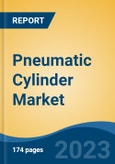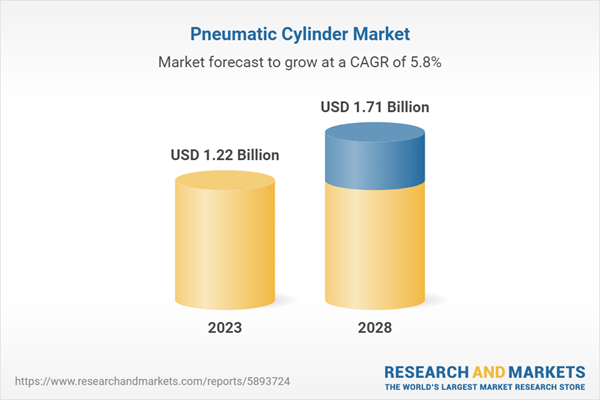Speak directly to the analyst to clarify any post sales queries you may have.
10% Free customizationThis report comes with 10% free customization, enabling you to add data that meets your specific business needs.
Pneumatic cylinders, also known as air cylinders, are mechanical devices that utilize compressed gas to generate torque and linear, reciprocating motion. They operate by propelling a piston, which can be in the form of a disc or cylinder, in a desired direction using an external force. The force generated by the piston is then transmitted through the piston rod to the object that needs to be pushed. Pneumatics are preferred by engineers due to their compact fluid storage requirements, quieter operation, cleanliness, and improved efficiency. In applications where cleanliness is crucial, such as in the mechanical puppets of the Disney Tiki Room, pneumatics is used to prevent any liquid leakage that can contaminate the surroundings, as the operating fluid in pneumatic cylinders is a gas.
Adoption of Industrial Internet of Things (IoT) and Rise of Smart Pneumatic Cylinders driving the market growth
The global pneumatic cylinder market is poised for future growth due to the integration of IoT technology into pneumatic cylinders. This development presents opportunities for end users responsible for machinery maintenance and operational efficiency. Companies now offer IoT solutions that gather data from machines and ensure smooth operations of systems and components. Consequently, end users are playing a significant role in driving the adoption of IoT within the pneumatic cylinder market.Pneumatic cylinders are widely utilized in industrial machines for motion control purposes. These cylinders are designed to move along a predefined path in two directions, with specific movement distances before coming to a halt. Major companies are currently focusing on manufacturing pneumatic cylinders that enhance performance and reduce emissions in sectors powered by gasoline. For example, in March 2021, Eaton introduced its next-generation sodium-filled head hollow valves, which improve the performance and fuel efficiency of gas-powered engines while minimizing pollutants. The unique valve design reduces engine knock and lowers the temperature in the cylinder chamber. These advanced products are expected to make significant contributions to the global pneumatic cylinder market during the forecast period.
Acceptance of Pneumatic Cylinder Robots Fueling the Market Growth
Pneumatic cylinders are widely favored for industrial automation applications due to their cost-effectiveness, low maintenance requirements, and ability to operate in extreme temperatures. Pneumatic cylinder robots, powered by compressed air, are utilized to expedite operations in industrial automation. This factor is expected to continue driving the growth of the global pneumatic cylinder market during the projected period.Several companies are strengthening their market positions by establishing new divisions and expanding their global sales of pneumatic cylinders for such applications. For example, in March 2020, Rotex Automation inaugurated a sales office in the Middle East as part of its efforts to enhance its global sales network. The headquarters of Rotex Automation is located in Ras Al Khaimah, United Arab Emirates, strategically positioned at a key hub. This location enables convenient access to products and services for customers and end users across Middle East and North Africa.
Increasing Construction Sector Propelling the Market Growth
The integration of pneumatic cylinders with equipment brings about enhancements in ease of use, accuracy, functionality, and controlled performance. Electro-hydraulic cylinders, also known as smart cylinders, are gaining popularity in the market due to their combination with servo valves and transducers. These components enable electrically operated valves and rod position input, ensuring efficient operations. The development of smart cylinders has mitigated the risks associated with alternative technologies, expanding the range of pneumatic cylinder applications and encompassing the use of electric actuators.The demand for pneumatic cylinders is expected to rise during the projected period due to the growth of the construction sector. According to a joint study by Global Construction Perspective (GCP) and Oxford Economics, the construction industry is projected to reach a value of USD15.5 trillion by 2030. Substantial growth is anticipated in countries such as the US, China, and India, which will drive the growth of the global pneumatic cylinder market alongside technological advancements in the main building and infrastructure sector, during the forecast period.
The cost of construction is influenced by factors such as material prices, labor expenses, construction equipment, and administrative costs. Labor costs account for a significant portion, ranging from 35% to 40% of the total construction cost. Labor costs can vary significantly depending on the availability of skilled labor in a particular region. The growth in the construction and related industries across several countries in Europe, the US, and Australia is expected to drive the demand for commodities such as cement and concrete. However, the shortage of truck drivers in the logistics of raw materials poses a major challenge to contractors. Despite rising labor costs, there is still a shortage of skilled workers in the construction industry. Additionally, the production and delivery of building materials are influenced by the volatile pricing in the oil market. Moreover, strict regulations on migrant labor in many European countries and geopolitical uncertainties may contribute to price inflation.
The global construction industry's revenue is projected to experience steady growth in the coming years, more than doubling by 2030. The market was valued at USD6.4 trillion in 2020 and is expected to reach USD14.4 trillion by 2030.
Growing Acceptance of Electric Actuators Restraining the Market Growth
The market for pneumatic cylinders is facing significant challenges due to the increasing adoption of electric actuators, which offer improved control and energy efficiency compared to pneumatic cylinders. This has led to a notable decline in the demand for pneumatic cylinders. The limited availability of substitutes, such as hydraulic cylinders and electronic actuators, has further constrained the global pneumatic cylinder market. Additionally, the volatility in raw material prices is impacting the market dynamics and shaping its development.Market Segmentation
The global pneumatic cylinder market is divided into by function, product type, cylinder type, movement, application, and region. Based on function, the market is segmented into substrate and inks. Based on product type, the market is segmented into single-acting and double-acting. Based on cylinder type, the market is divided into with piston rods, rod less, diaphragm, and rotary. Based on movement, the market is divided into linear and rotary. Based on application, the market is split into construction, oil & gas, robotics, automotive, aviation, healthcare, and others. Based on region, the market is divided into North America, Asia-Pacific, Europe, South America, and Middle East & Africa.Market Players
Major market players in the global pneumatic cylinder market are SMC Corporation, Festo, Imperial Metal Industries Limited (IMI), Parker Hannifin Corporation, Aventics, Aro (Ingersoll Rand), Univer S.p.A., Camozzi, Metal Work S.p.A, Airtac, Ashun Fluid Power Co, and Bimba Manufacturing Co.Report Scope:
In this report, the global pneumatic cylinder market has been segmented into following categories, in addition to the industry trends which have also been detailed below:Pneumatic Cylinder Market, By Function:
- Substrate
- Inks
Pneumatic Cylinder Market, By Product Type:
- Single-Acting
- Double-Acting
Pneumatic Cylinder Market, By Cylinder Type:
- With Piston Rods
- Rod less
- Diaphragm
- Rotary
Pneumatic Cylinder Market, By Movement:
- Linear
- Rotary
Pneumatic Cylinder Market, By Application:
- Construction
- Oil & Gas
- Robotics
- Automotive
- Aviation
- Healthcare
- Others
Pneumatic Cylinder Market, By Region:
- North America
- United States
- Canada
- Mexico
- Asia-Pacific
- China
- India
- Japan
- South Korea
- Indonesia
- Europe
- Germany
- United Kingdom
- France
- Russia
- Spain
- South America
- Brazil
- Argentina
- Middle East & Africa
- Saudi Arabia
- South Africa
- Egypt
- UAE
- Israel
Competitive Landscape
Company Profiles: Detailed analysis of the major companies present in the global pneumatic cylinder market.Available Customizations:
Global pneumatic cylinder market report with the given market data, the publisher offers customizations according to a company's specific needs.This product will be delivered within 1-3 business days.
Table of Contents
Companies Mentioned
- SMC Corporation
- Festo.
- Imperial Metal Industries Limited (IMI)
- Parker Hannifin Corporation
- Aventics
- Aro (Ingersoll Rand)
- Univer S.p.A.
- Metal Work S.p.A
- Airtac, Ashun Fluid Power Co
- Bimba Manufacturing Co
Table Information
| Report Attribute | Details |
|---|---|
| No. of Pages | 174 |
| Published | October 2023 |
| Forecast Period | 2023 - 2028 |
| Estimated Market Value ( USD | $ 1.22 Billion |
| Forecasted Market Value ( USD | $ 1.71 Billion |
| Compound Annual Growth Rate | 5.7% |
| Regions Covered | Global |
| No. of Companies Mentioned | 10 |









